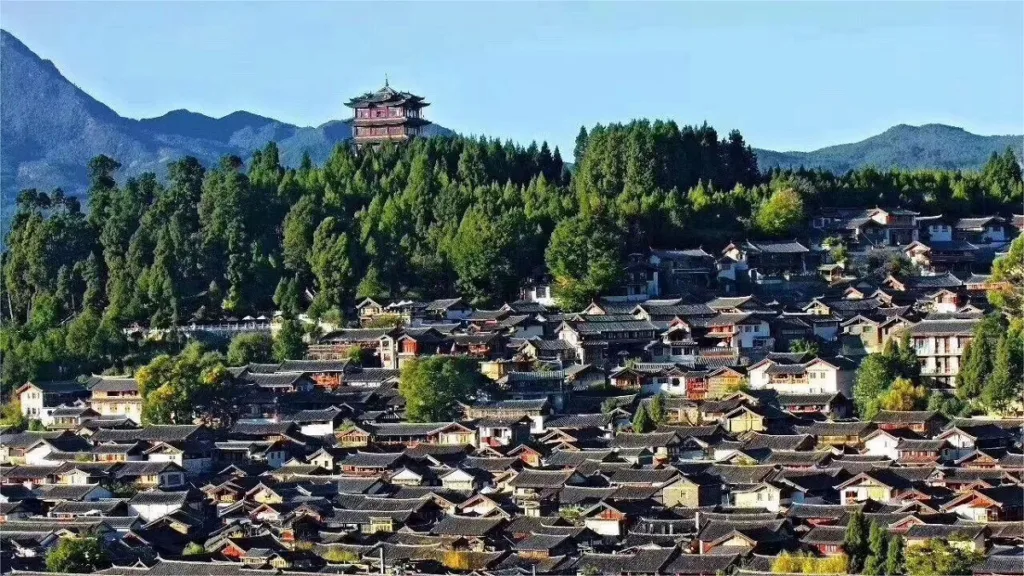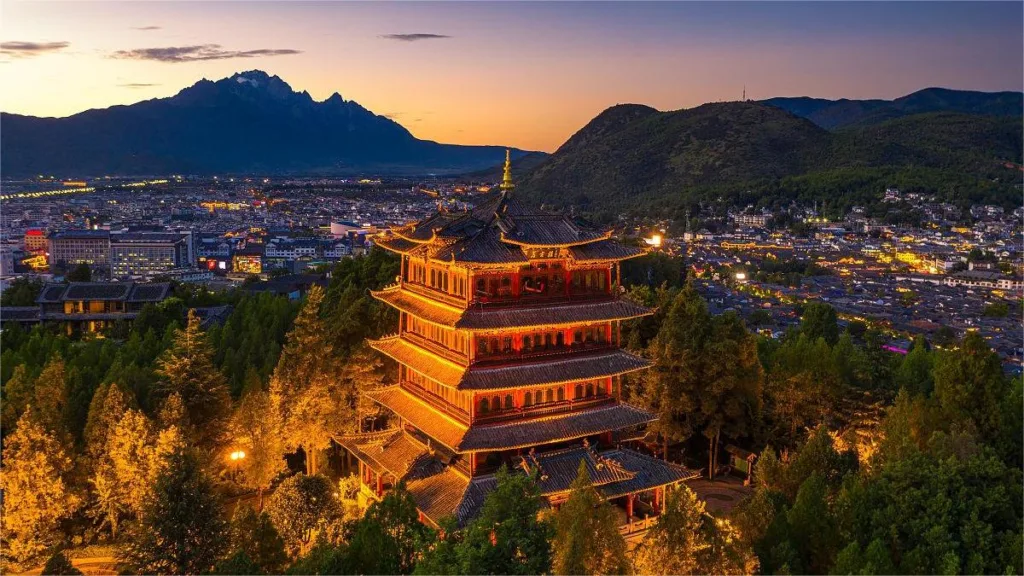Black Dragon Pool Park (黑龙潭公园), originally a temple dedicated to the Dragon King, was built in the second year of the Qianlong era (1737) in Lijiang. It underwent renovations in the sixtieth year of Qianlong’s reign and in the eighteenth year of the Guangxu era. Numerous springs beside the temple formed a pond. Known for its jade-like water, which reflects the Yulong Snow Mountain, it is also called “Jade Spring Park.” This area serves as both the water source for the ancient city of Lijiang and the location with the highest concentration of nationally protected cultural relics in Lijiang.
Black Dragon Pool Park is renowned as the best location for capturing views of the Yulong Snow Mountain. The image composed of the Five-Hole Bridge, the Moon-Embracing Pavilion, the snow-capped mountain, and its reflection in the pool has become a classic scenic postcard of Lijiang. The best times for photography are early morning and late afternoon when the mountain is illuminated by the best light. However, it’s worth noting that during the rainy season in June and July, the opportunity to see the mountain’s reflection is relatively low.
Table of Contents
- Basic Information
- Location and Transportation
- Ancient Buildings in Black Dragon Pool Park
- Vlog about Black Dragon Pool Park
- Other Attractions in Old Town of Lijiang
Basic Information
| Estimated Length of Tour | 1 – 2 hours |
| Ticket Price | 50 RMB |
| Opening Hours | 7.30 – 21.00; Last admission: 20.00 |
| Telephone Number | 0086-0888-5188041 |
Location and Transportation
The Black Dragon Pool Park is situated at the foot of Xiangshan Mountain in the northern part of the city, at 1 Minzhu Road, Gucheng District, Lijiang City, Yunnan Province. To get there, you can take bus 4 or 13 and get off at Xiangshan Road Intersection Stop (象山路口站).
Ancient Buildings in Black Dragon Pool Park

Wufeng Tower (五凤楼), also known as the Fuyun Pavilion, was originally located within the Fuguo Temple on Zhishan Mountain. It was relocated to the Black Dragon Pool Park in 1979. The Fuguo Temple, built during the Ming Dynasty, served as a villa and ancestral temple for the Mu family, who once hosted the renowned Ming Dynasty traveler and geographer Xu Xiake.
The Dragon God Temple (龙神祠) is the main structure within the Black Dragon Pool Park. Oriented east to west, this temple complex features four courtyards. It includes a gate tower, side chambers, and a main hall with a spacious platform in front. The towering gate tower bears the inscription “Heavenly Light and Cloud Shadows (天光云影).”
The Suocui Bridge (锁翠桥), also known as the Locks Green Bridge, is a covered corridor-style bridge built during the Qing Dynasty. Its distinctive features include flying eaves and carved ancient plaques bearing the inscriptions “Yangqing (漾青)” and “Suocui (锁翠)” at the bridgehead.

Yiwen Pavilion (一文亭), constructed during the mid-Qing Dynasty, was originally located in front of the Guangbi Building in the ancient city of Lijiang. Legend has it that it was funded by donations of one copper coin each from local Naxi elderly women, hence its name, which translates to “One Copper Coin Pavilion.”
Wenming Archway (文明坊) serves as the main entrance to the Black Dragon Pool Park. Originally built during the 16th year of the Guangxu Emperor’s reign in the Qing Dynasty, it was relocated to its current location in 1966. Flanked by four stone lions dating back to the Ming Dynasty, it was formerly a plaque archway for the Wenmiao Temple.
Lovesick Bridge (相思桥), also known as the Five-Hole Bridge or the Jade Belt Bridge, spans the Black Dragon Pool, dividing its waters. Carved stone elephants and lions adorn the bridge’s railings, and its name is derived from the phonetic similarity between “xiangshi” (lion alike) and “xiangsi” (lovesick).

The Ancient Opera Stage (古戏台), located in front of the Dragon God Temple, is one of the oldest opera stages in the Lijiang region. Visitors can enjoy performances of traditional Naxi music, often referred to as the “living fossil of oriental music.”
Jietuo Forest (解脱林), built during the Wanli era of the Ming Dynasty, was originally the main gate of the Fuguo Temple bestowed by Emperor Zhu Yousong. In the 1970s, it was relocated and reconstructed within the Black Dragon Pool Park.
Guangbi Building (光碧楼), dating back to the Wanli era of the Ming Dynasty, was later restored during the Qianlong era of the Qing Dynasty. Originally serving as a library for the Mu family, it features exquisite carvings of birds, flowers, and auspicious symbols.
Wanshou Pavilion (万寿亭), meaning “Pavilion of Longevity,” was constructed by the chairman of the Thai M Group to commemorate his mother’s 80th birthday. Adorned with twenty-four filial piety-themed images, the pavilion overlooks the lake, nestled among lush trees and bamboo.







